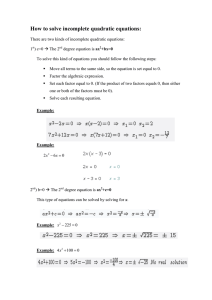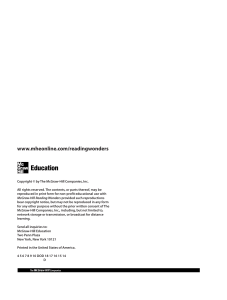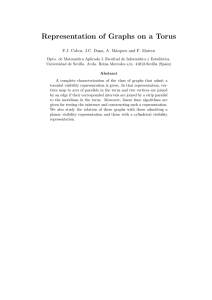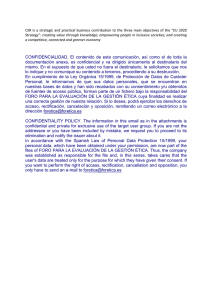Algebra I - EL Saber Enterprises
Anuncio
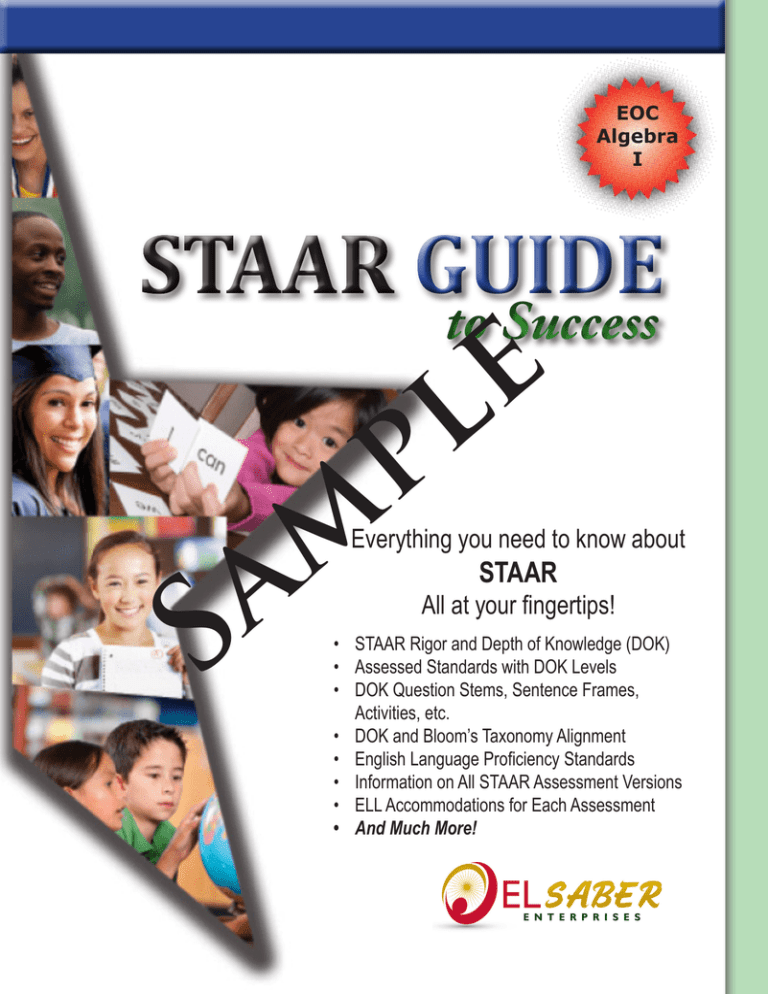
EOC Algebra I GUIDE to Success e l p m a Everything you need to know about S STAAR All at your fingertips! • STAAR Rigor and Depth of Knowledge (DOK) • Assessed Standards with DOK Levels • DOK Question Stems, Sentence Frames, Activities, etc. • DOK and Bloom’s Taxonomy Alignment • English Language Proficiency Standards • Information on All STAAR Assessment Versions • ELL Accommodations for Each Assessment • And Much More! Increased Rigor STAAR’s Increased Rigor FOCUS DESIGN ATTRIBUTES • A distinction has been made between “readiness” and “supporting” standards from the TEKS content standards eligible for assessment. • A set of readiness standards has been identified for each subject and grade or course drawn from the TEKS content standards eligible for assessment. • Readiness standards will be emphasized annually in the STAAR assessments. READINESS STANDARDS • They are essential for success in the current grade or course. • They are important for preparedness for the next grade or course. • They support college and career readiness. • They necessitate in-depth instruction. • They address broad and deep ideas. e l p SUPPORTING STANDARDS • Although introduced in the current grade or course, they may be emphasized in a subsequent year. • Although reinforced in the current grade or course, they may be emphasized in a previous year. • They play a role in preparing students for the next grade or course but not a central role. • They address more narrowly defined ideas. m a CLARITY DESIGN ATTRIBUTES S • Assessments focus is on readiness standards and course-specific content standards. • The majority of the assessments will test content studied that year. • In reading, greater emphasis will be given to critical analysis than literal understanding. DESIGN ATTRIBUTES DEPTH DEPTH • Includes a greater number of items that have a higher cognitive complexity level. • Items will more closely match the cognitive complexity level evident in the TEKS. • In writing, students will be required to write two essays rather than one. The writing prompts will support analytical, persuasive, and expository writing in addition to literary writing. • In social studies, science, and mathematics, process skills will be assessed in context, not in isolation, which will allow for a more integrated and authentic assessment of these content areas. • In science and mathematics, the number of open-ended (griddable) items will increase to allow students more opportunity to derive an answer independently. 2 Adapted from Texas Education Agency ©2013 by EL Saber Enterprises. All rights reserved. Algebra I Readiness and Supporting Standards Readiness Standards Supporting Standards Reporting Category 1: Functional Relationships. Student will describe functional relationships in a variety of ways. 1.D represent relationships among quantities using [concrete] models, tables, graphs, diagrams, verbal descriptions, equations, and inequalities; DOK 2 1.E interpret and make decisions, predictions, and critical judgments from functional relationships. DOK 3 1.A describe independent and dependent quantities in functional relationships; DOK 1 1.B gather and record data and use data sets to determine functional relationships between quantities; DOK 2 1.C describe functional relationships for given problem situations and write equations or inequalities to answer questions arising from the situations; DOK 2 Reporting Category 2: Properties and Attributes of Functions. Student will demonstrate an understanding of the properties and attributes of functions. 2.B identify mathematical domains and ranges and determine reasonable domain and range values for given situations, both continuous and discrete; DOK 2 2.D collect and organize data, make and interpret scatterplots (including recognizing positive, negative, or no correlation for data approximating linear situations), and model, predict, and make decisions and critical judgments in problem situations. DOK 3 4.A find specific function values, simplify polynomial expressions, transform and solve equations, and factor as necessary in problem situations; DOK 2 2.A identify and sketch the general forms of linear (y = x) and quadratic (y = x2) parent functions; DOK 2 2.C interpret situations in terms of given graphs or create situations that fit given graphs; DOK 2 3.A use symbols to represent unknowns and variables; DOK 1 3.B look for patterns and represent generalizations algebraically. DOK 2 4.B use the commutative, associative, and distributive properties to simplify algebraic expressions; DOK 1 e l p 4.C connect equation notation with function notation, such as y = x + 1 and f (x) = x + 1. DOK 1 Reporting Category 3: Linear Functions. Student will demonstrate an understanding of linear functions. 5.C use, translate, and make connections among algebraic, tabular, graphical, or verbal descriptions of linear functions. DOK 2 6.B interpret the meaning of slope and intercepts in situations using data, symbolic representations, or graphs; DOK 2 5.A m a 6.C investigate, describe, and predict the effects of changes in m and b on the graph of y = mx + b; DOK 2 6.F interpret and predict the effects of changing slope and y-intercept in applied situations; DOK 2 S 5.B 6.A determine whether or not given situations can be represented by linear functions; DOK 2 determine the domain and range for linear functions in given situations; DOK 2 develop the concept of slope as rate of change and determine slopes from graphs, tables, and algebraic representations; DOK 2 6.D graph and write equations of lines given characteristics such as two points, a point and a slope, or a slope and y-intercept; DOK 2 6.E determine the intercepts of the graphs of linear functions and zeros of linear functions from graphs, tables, and algebraic representations; DOK 2 6.G relate direct variation to linear functions and solve problems involving proportional change. DOK 2 Reporting Category 4: Linear Equations and Inequalities. Student will formulate and use linear equations and inequalities. 7.B 8.B investigate methods for solving linear equations and inequalities using [concrete] models, graphs, and the properties of equality, select a method, and solve the equations and inequalities; DOK 2 7.A analyze situations involving linear functions and formulate linear equations or inequalities to solve problems; DOK 2 7.C interpret and determine the reasonableness of solutions to linear equations and inequalities. DOK 2 solve systems of linear equations using [concrete] models, graphs, tables, and algebraic methods; DOK 2 8.A analyze situations and formulate systems of linear equations in two unknowns to solve problems; DOK 2 8.C interpret and determine the reasonableness of solutions to systems of linear equations. DOK 2 Reporting Category 5: Quadratic and Other Nonlinear Functions. Student will demonstrate an understanding of quadratic and other nonlinear functions. 9.D analyze graphs of quadratic functions and draw conclusions. DOK 2 9.A determine the domain and range for quadratic functions in given situations; DOK 1 10.A solve quadratic equations using [concrete] models, tables, graphs, and algebraic methods; DOK 2 9.B investigate, describe, and predict the effects of changes in a on the graph of y = ax2 + c; DOK 3 9.C investigate, describe, and predict the effects of changes in c on the graph of y = ax2 + c; DOK 3 4 ©2013 by EL Saber Enterprises. All rights reserved. Webb’s Depth of Knowledge Depth of Knowledge (DOK) Level 1 Level 1 tasks involve comprehension and application at a surface level which do not require any further mental manipulation or processing of the information beyond recall or reproduction. There is little transformation or extended processing of the target knowledge required. Evaluation at this level would require recall or recognition of a fact, information, concept, or procedure. Key Characteristics • Basic recall of facts, vocabulary, and attributes of objects • Application of simple procedures or formulas • Common tasks include listing, identifying, and defining Student Roles Memorizes Interprets Responds Describes Restates Demonstrates Explains Remembers Recognizes Question Stems for Teachers Reading Remember Recite a fact related to . . . Understand Paraphrase a chapter in the book. Apply Prepare a flow chart that illustrates the sequence of events. Evaluate Create p Remember Understand Apply m a S • ____ is when ____. • ____ happened before/after ____. • ____ was the person/character that ____. • I recognize ____ by looking at/thinking about ____. • ____ means ____. • I can find the meaning of ____ by ____. • I would write ____ like this ____. • I would include ____ because ____. • ____ has ____ and ____. • ____ looks/feels/smells/sounds/tastes like ____. e l Analyze Math • Can you recall ____? • When did ____ happen? • Who was ____? • How can you recognize ____? • What is____? • How can you find the meaning of____? • How would you write ____? • What might you include on a list about____? • Can you identify____? • How would you describe____? Sentence Frames for Students Activities Across Bloom’s Taxonomy Analyze Identify missing points in outline. Recommend a book and justify recommendation. Modify the ending of the story. Recognize a property. Outline main points. Use basic calculation tasks to solve one step problems. Identify missing points in formula. Evaluate Justify process of using formula. Create Make a chart showing how to solve a given problem. Science Remember Recall scientific steps in a process. Understand Illustrate a relationship between . . . Apply Follow simple instructions to complete a lab. Analyze Retrieve information from an illustration or chart. Evaluate Review peer description of topic for accuracy. Create Brainstorm ideas related to . . . Possible Products Quiz Example Definition Podcast Commenting Collection Wiki Explanation Label Fact Highlights Show and Tell Categorize The Depth of Knowledge levels along with its principal components have been adapted from Dr. Norman Webb’s research and work. ©2013 by EL Saber Enterprises. All rights reserved. 7 Algebra I Academic Vocabulary Algebra I RC 1 - FUNCTIONAL RELATIONSHIPS equation notation P ecuación notación critical judgment opinión crítica factor P factores data JP datos function notation P notación funcional data set conjunto de dato function values P valores funcionales decision P decisión generalization P generalización dependent quantity P cantidad dependiente graph JHP gráfica describe JP describir identify P identificar diagram HP diagrama interpret JP interpretar equation JP ecuación linear function JP función lineal functional relationship JP relación funcional linear situation P situación lineal gather data recolectar datos domain P graph JHP gráfica model HP independent quantity P cantidad independiente negative HP inequality J desigualdad no correlation interpret JP interpretar organize data P model HP modelo parent function prediction P predicción pattern P problem situation JP situación problemática polynomial P quantity cantidad positive HP record data anotar datos predict JP relationship relación problem situation JP situación problemática represent P representar property JP propiedad situation JP situación quadratic function JP función cuadrática table JHP tabla range JH gama reasonableness razonable recognize P reconoce expresión algebraica represent P representar algebraicamente scatterplot diagrama de dispersión aproximando simplify JP simplificar propiedad asociativa situation JP situación recaudar datos sketch H bosquejo propiedad comunicativa symbol P símbolo conectar transform P transformar continuous P continuo value P valor create P crear variable critical judgment opinión crítica variable P RC 3 - LINEAR FUNCTIONS data JP datos algebraic representation P representación algebraica decision P decisión apply P aplicar determine JP determinar characteristic P característica discrete situation P situación discreta concept of slope el concepto de una inclinación distributive property P propiedad distributiva connection P conexión domain JP dominio data JP datos algebraic expression P algebraically P approximating P associative property P collect data commutative property P connect P p S J High-frequency (appears more than 3 times) 26 modelo m a descripción verbal verbal description P RC 2 - PROPERTIES AND ATTRIBUTES OF FUNCTIONS e l dominio H Multiple-meaning ©2013 by EL Saber Enterprises. All rights reserved. negativo sin correlación organizar datos función madre patrón polinomial positivo predecir P Cognate
